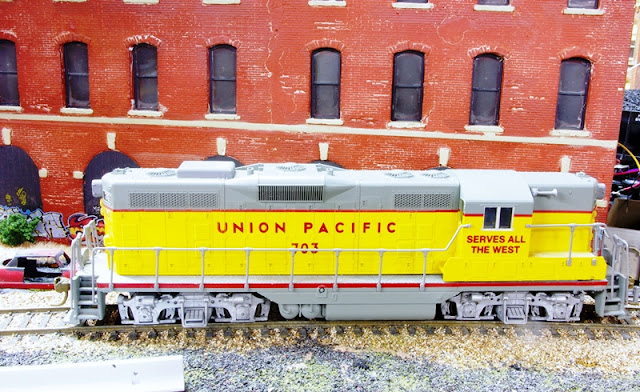This is pretty beat-up and too flimsy to run, so it sits in a display case. However, in the early 1980s, I was looking back fondly on some of those early total scratchbuilding efforts. At the time, I had access to a table saw and found some scrap 2x4s at a construction site. The wheels started turning, and I began to mass-produce wood hopper car bodies. I finished something like eight or a dozen of these, and not long ago I ran across a stash of unfinished versions from this project.
My idea at the time was to build a unit train of PRR H39 hoppers like those I'd seen in the 1960s on the Northeast Corridor. Here is one of the finished ones I found, long packed away:
There were some good ideas there, but there were also some flaws in my thinking. The biggest one was that I could use dummy couplers, since it was a unit train. Nope -- more recently, companies like Walthers have had the same bad idea on coal gons and such. Dummy couplers are too fussy to mess with, even on a unit train. So I had to back off and replace them with Kadee 158s.
The other thing I found was that plastic and brass cars are engineered so they basically run when you put them on the track. With dimensional tolerances much greater in this project, I eventually discovered that things would happen like wheels scraping on the hopper bottoms. Here's where I had to carve out recesses so the car would actually run:
The partially finished bodies I found will give an idea of what I did. I started with a piece of scrap 2x4 and basically rough-cut away everything that didn't look like a PRR H39:
I think this one must have been a reject from the production line, since I can see a big discrepancy, but you get the idea. I would set up the saw for each set of cuts and run a whole bunch of wood blocks through, so this was true mass production.
Then I would finish the shapes of the hopper bottoms with a sanding disk in a Dremel, smooth out the sides, apply several coats of sanding sealer, and mark out the ribs. I also drilled holes in the top to take low-temperature alloy to bring the car to NMRA weight.
The center sill was brass square tubing, also filled with low-temp alloy. The bolsters were standard Northeastern wood, that you could still get at the hobby shop then:
Here you can see the process a little farther along, with wood shapes added for the ribs:
Although I did finish eight or a dozen of these, it looks like I stopped before I finished all of them. I'm not sure if you can even get the same wood shapes these days, but now that I look these over, I could probably finish them with styrene shapes. Hmm.
I should probably dig out some of the finished ones, for that matter, and put them into operation. The finished one here, with NMRA weight built in and upgraded with Kadees, is now in my operating fleet.





















































